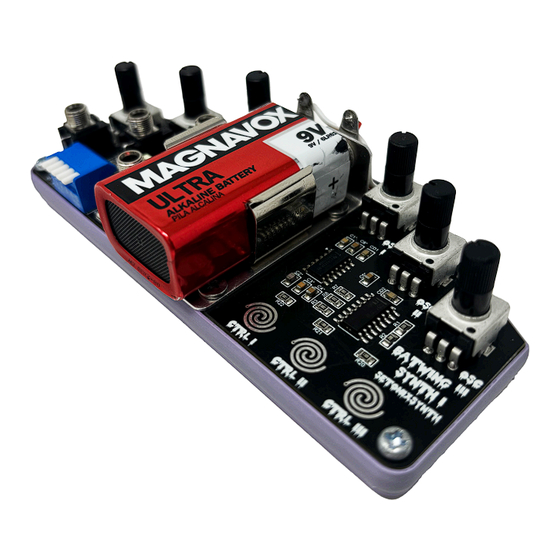Advertisement
Quick Links
Batwing Synth I
Noise/Drone Synthesizer Assembly Instructions + User Manual
Copyright 2024 SetonixSynth. All rights reserved.
DIY Kit Bill of Materials:
Quantity
1
1
6
4
6
1
1
1
Part
9V battery
Keystone 1290 battery holder
M3 x 6mm screw, thin head
Thonkiconn 3.5mm jack
B100k pot
Slide switch
5-Pin Dip Switch
470nF capacitor
Advertisement

Summary of Contents for SetonixSynth Batwing Synth I
- Page 1 Batwing Synth I Noise/Drone Synthesizer Assembly Instructions + User Manual Copyright 2024 SetonixSynth. All rights reserved. DIY Kit Bill of Materials: Quantity Part 9V battery Keystone 1290 battery holder M3 x 6mm screw, thin head Thonkiconn 3.5mm jack B100k pot...
- Page 2 Assembly Instructions: 1. Review the bill of materials and make sure you have everything necessary before proceeding with the build. 2. Place the 470nF film capacitor in the footprint labeled C7, in between the spaces for the In II and Out jacks. Use a finger to hold the cap in place, then flip over the PCB and solder one leg of the cap.
- Page 3 8. At this point you should have fully soldered everything except the battery holder. Flip over the board and inspect each footprint to make sure everything is cleanly soldered, and that nothing is shorted together. 9. Attach the PCB to the bottom tray by inserting M3 screws into the two screw holes in the bottom corners, next to the Mode Select switch and Control III pad.
-
Page 5: Signal Flow Diagram
Signal Flow Diagram: User Manual: The Batwing Synth is a hacky noise box in the most traditional sense, using only common off-the-shelf components to generate the strangest and wildest sounds possible. While it can be a little overwhelming when first powered on after the build, there is a method to the madness. Understanding the functions of your Batwing Synth is a great first step to getting the coolest sounds out of it, though of course just messing around can be fun too. -
Page 6: Summary Of Controls
Summary of Controls: Audio Oscillator Controls: set the initial frequency of the three (usually) audio-rate oscillators which tell the Multiplexer which input to select. Control Pads: touch points for altering the frequency of the audio oscillators, with each pad corresponding to the knob directly above it. LFO Rate Controls: set the initial frequency of the three (usually) LFO-rate oscillators which act as variable sources of Data for the multiplexer.


Need help?
Do you have a question about the Batwing Synth I and is the answer not in the manual?
Questions and answers